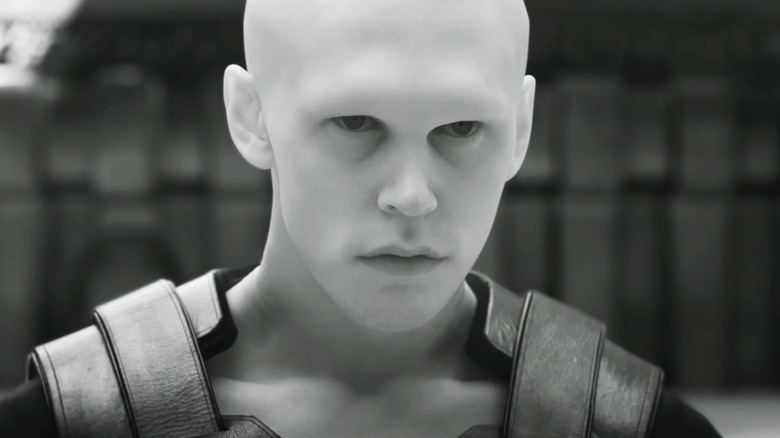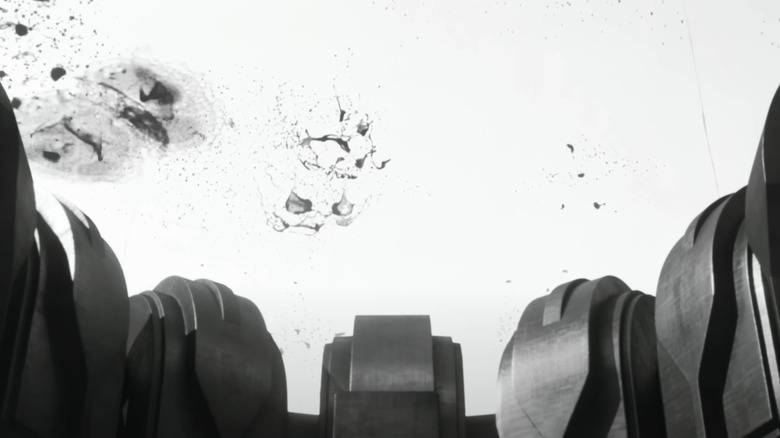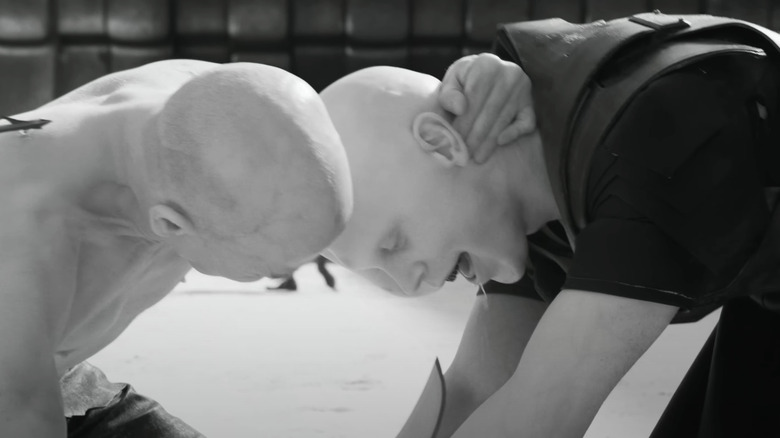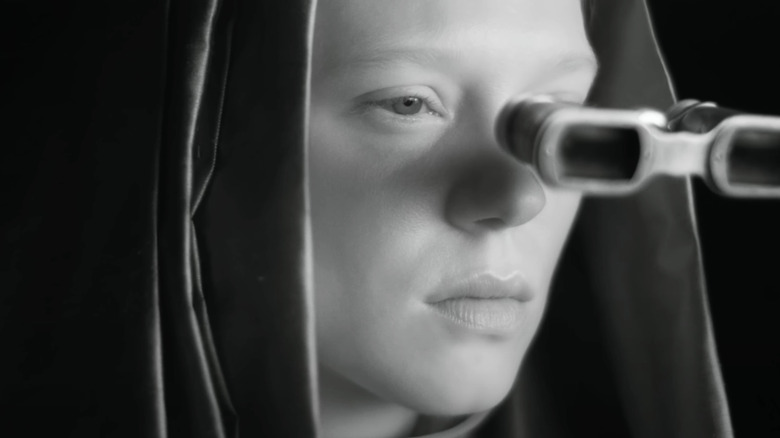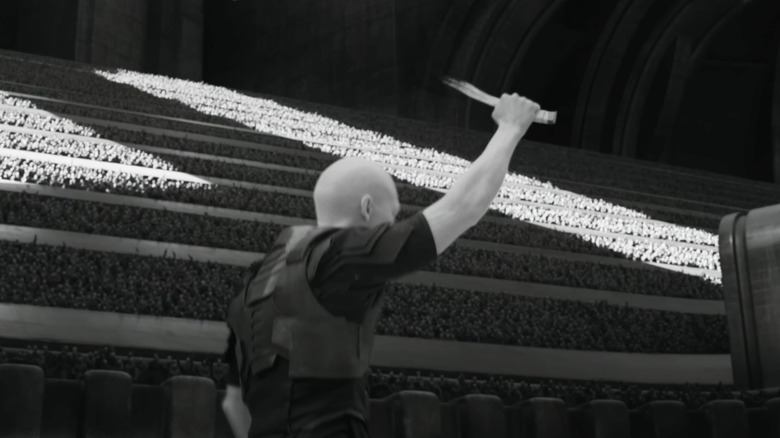Dune 2 Used Video Game Tech And Infrared Cameras To Perfect The Harkonnen Arena Fight
We may receive a commission on purchases made from links.
From keeping footprints out of frame to the VFX team having to create a whole technique for the hologram scenes, everything about Denis Villeneuve's "Dune" and its sequel required meticulous attention to detail and a willingness to innovate in order to bring Frank Herbert's 1965 story to life. One of the best examples of this is the Harkonnen arena battle from "Dune: Part Two," in which three Atreides soldiers face off against Austin Butler's vicious warrior Feyd-Rautha Harkonnen.
Shot entirely in monochrome, this sequence stands out not only for its distinct visual style but for its intensity and the creeping sense of doom it evokes. As Feyd-Rautha, nephew of the Baron Vladimir Harkonnen (Stellan Skarsgård), takes on the captured Atreides soldiers, his unbridled glee at ending their lives and the roars of the Harkonnen crowd establish Butler's character as a palpably menacing threat to Timothée Chalamet's Paul Atreides and his quest to liberate the planet Arrakis.
But much like the rest of Villeneuve's "Dune" duology, the quality and sleekness of this arena battle sequence belies the level of technical innovation and attention to detail that went into pulling it off.
Cinematographer Greig Fraser was integral to the Dune films
Much like the Baron and his project to conquer Arrakis, with "Dune" and "Dune: Part Two," Denis Villeneuve found himself confronted with a truly gargantuan task. Luckily, he had his own trusted foot soldiers who could help him bring his epic vision to life. One of the most important was cinematographer Greig Fraser, who truly pushed the limits of what a DP is required to do on a movie like this.
Fraser joined Villeneuve and production designer Patrice Vermette in planning scenes down to the finest detail. While Vermette was bottling sand from various places in the deserts of Abu Dhabi and Jordan, Fraser was, as noted in the book "The Art and Soul of Dune: Part Two," using "3D Unreal Engine software, photogrammetry, drones, and ground lidar scanning" to pre-visualize every shot of the film and plan the perfect time of day to shoot in certain locations. Capturing a real eclipse in the Jordanian desert was about the only thing that seemingly happened by chance; everything else was meticulously laid out beforehand.
The Arena battle was no different. Set on the Harkonnen homeworld of Giedi Prime, the clash takes place in the open air beneath a black sun. It's the first time audiences see the exterior of Giedi Prime, and in order to depict what is described in Frank Herbert's novel as a monochromatic environment, Fraser decided to shoot the whole thing in black and white. But this wasn't as simple as desaturating the footage in post. No, to create the ominous, otherworldly monochrome of the arena battle, Fraser decided to shoot in infrared.
Shooting in infrared came with its own challenges
In the arena scene, you can see the influence of a classic horror movie on the look of the Harkonnen hordes in the stands, all of whom were designed to emulate the look of Count Orlock from 1922's "Nosferatu." This reference is enhanced by the use of monochrome, which highlights the spectators' pallid complexions. But actually achieving this monochrome look was much harder than you might think.
Co-author of "The Art and Soul of Dune: Part Two," Tanya LaPointe, was also a producer on the film, explains in the book how the arena battle was shot, recalling how it was filmed "outdoors during a heat wave in Budapest." She continued, "Greig had been kicking around the idea of working with infrared technology for years, and it seemed appropriate to create the effect of the 'sunlight-killing colors' that Denis described."
LaPointe recalls how Fraser removed the IR filters from existing cameras and justified the choice by claiming that "the skin tone becomes very translucent, like it's glowing from within," which just added to the ambient level of eeriness. However, this choice also came with its own challenges. Most notably, it meant that certain fabrics and textures appeared differently on camera. As Lapointe writes:
"Even though a piece of clothing was black to the naked eye, it didn't necessarily appear that way onscreen. This was a challenge for the costume department. 'We had to test every single piece of fabric featured in the scene,' recalled Jacqueline [West, Costume Designer], 'holding it up in front of that camera to see if it would look black or white.' This resulted in having to remake some of the costumes, or parts of them, based on which ones Denis wanted to see in black in this scene."
Greig Fraser had more than infrared issues to worry about on Dune: Part Two
Interestingly enough, in a separate interview with ARRI, the company who supplied the cameras for the "Dune" films, Greig Fraser recalled how he'd previously used modified ARRI ALEXA 65s on 2016's "Rogue One: A Star Wars Story" to do "exactly the same thing" that he did with the arena scene in "Dune: Part Two". The cinematographer said, "We used them as VFX cameras, lighting parts of the set with IR light that didn't affect the main image. We just took that a step further and used them as our main cameras for Giedi Prime." Fraser had also experimented with infrared on "Zero Dark Thirty," but "Dune: Part Two" was the perfect chance to embrace the style for an entire setting, regardless of the challenges it raised.
However, it wasn't just shooting in infrared that made the arena battle a true ordeal to shoot. Besides the heat wave and having to redesign costumes to work with IR, Fraser also applied his meticulous pre-production planning to the entire sequence, using the Unreal Engine software to, as noted in "The Art and Soul of Dune: Part Two," "recreate the outdoor [arena] set in three dimensions and carefully calculate the sun path throughout the day." It can't have been all that helpful that the outdoor set in question was actually a converted parking area between two soundstages.
Creating the Harkonnen arena in a parking lot
As Tanya LaPointe explains in the book, the actual Harkonnen arena set, built in what was essentially a parking lot, served as a "virtual environment" on which Austin Butler — who was already sweating beneath hefty prosthetics after Denis Villeneuve decided to make Feyd Rautha bald in "Dune: Part Two" — could do his thing. The set was constructed using four walls, "all of which were painted gray so that they could later be replaced with digital renderings of the arena." The final element was the sand itself, which was brought in to cover the ground of this surprisingly meager set. As LaPointe writes:
"Standing on this set felt like being in a gray box with no visual reference to indicate the scope and scale of the architecture that would be featured in the movie. Setting up every shot of the sequence required calculating where Feyd-Rautha stood in relation to the Baron's box, as well as the Bene Gesserit box from which both the Baron and Lady Fenring are observing him."
Essentially, then, Denis Villeneuve, his crew, and the actors all had to pretend a small sandbox surrounded by gray walls was the magnificent and imposing Harkonnen arena, always keeping in mind the position of the key onlookers, Baron Vladimir Harkonnen and Lea Seydoux's Lady Fenring. That's to say nothing of Butler's extensive makeup, the costumes, Fraser's pre-production planning, or the infrared element. To hear more about the making of the movie, check out our interview with Fraser on the /Film Daily podcast embedded at the bottom of this article.
